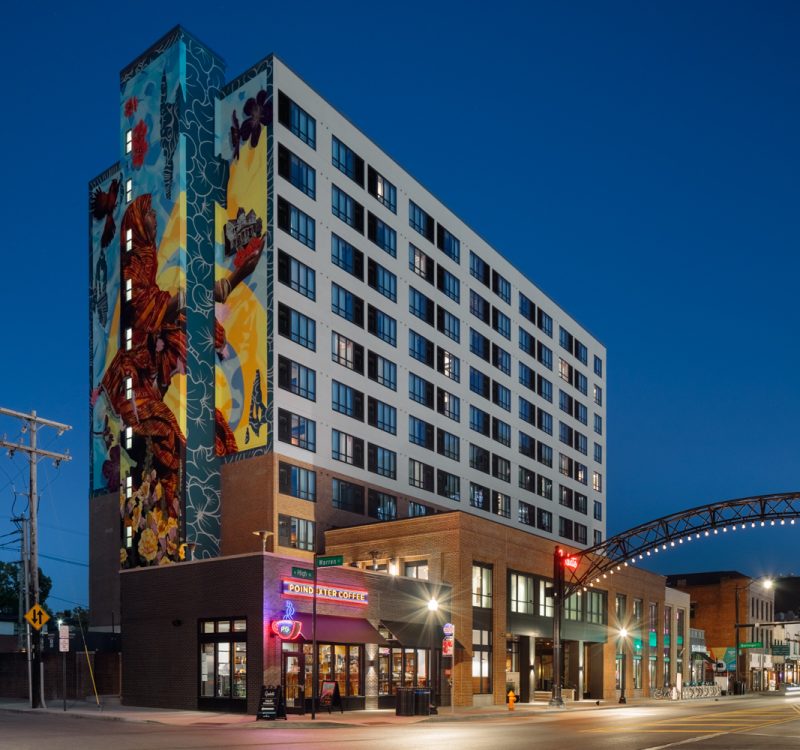How Art Shapes Memorable Spaces

Art is a powerful tool that can shape and transform spaces into memorable experiences. It goes beyond a mere visual element in the design of a building; it allows people to tell stories, attach emotionally, and interpret new meanings. From paintings and sculptures to installations and murals, art echoes the artist’s creativity and imagination, leaving a profound and lasting impact on viewers.
Art is integral to the guest experience at the Hilton Downtown Columbus. The artwork was curated from Ohio-based artists for a distinctly Ohio locale.
Art Shapes the Experience
Whether it’s a serene and calming piece that brings tranquility to a space or a bold and striking large-scale installation that commands attention, art can shape the experience of those who encounter it.
Art can evoke a wide range of emotions, from joy and wonder to contemplation and introspection. This emotional response can catalyze building connections and spark conversations within the community it inhabits. Often, these conversations are ones the community is already having, and amplifying the stories and experiences of the artist allows individuals and groups to experience the perspectives of others. This process fosters understanding, empathy, and a more caring community.
By reflecting the culture and values of the community, art becomes a powerful medium for social cohesion and cultural exchange.
Incorporating Art in the Design Stages
To unleash the full potential of art within a space, it should be considered early on in the design process. This collaborative journey, involving architects, interior designers, clients, artists, and curators, ensures that each aspect of the space is thoughtfully crafted to magnify the impact of artworks. It’s about aligning the art with the community’s essence, tapping into the intrinsic value of the local culture.
This artistic integration isn’t just about aesthetics; it’s a harmonious partnership that navigates the complexities of the project. Together, the team makes decisions, navigates budgets, optimizes space utilization, and understands codes and regulations.
By weaving art into the fabric of the design process, it becomes an inseparable part of the environment. This thoughtful incorporation elevates the overall design and ambiance, resulting in a seamless fusion of art and architecture that enriches the entire experience for the people in the space.
Charles Penzone’s colorful art collection provided inspiration for Penzone Hamilton Quarter’s interior design.
The Benefits for commercial real estate developers
The advantages of seamlessly integrating art into real estate spaces transcend the realm of aesthetics. Drawing from insights in the field, it’s evident that art installations wield the remarkable power to elevate a property’s overall visual and sensory experience. This enhancement creates a compelling allure for potential tenants and visitors, leaving a lasting impression.
What’s more, the mere presence of art within a property can be transformative for its market value, becoming an attractive investment opportunity. Real estate developers who actively engage with their surrounding communities through art not only fortify their standing but also cultivate a sense of loyalty among tenants, contributing to higher tenant retention rates. By facilitating cultural experiences and art, these developers breathe life into their communities, making them even more appealing destinations for residents, workers, and visitors alike.
Crucially, the symbiotic relationship between art and real estate extends to the economic sphere. It’s been demonstrated that regions boasting a robust artistic presence tend to magnetize businesses, tourists, and new residents. This influx of economic activity translates into higher tenant occupancy rates, a surge in commerce, and an enriched social fabric. Integrating art into these spaces doesn’t merely enhance their physical environment; it serves as a catalyst for bolstering the economic and social well-being of the entire community.
AC Hotel Dayton’s art collection recalls Dayton’s history as an industrial hub in the era of the Wright Brothers’ first plane and a newly booming auto industry. The collection nestles in with the surrounding eclectic blend of contemporary and historic architecture.